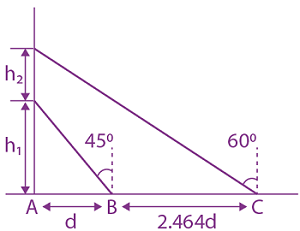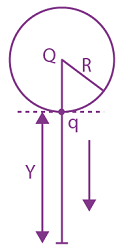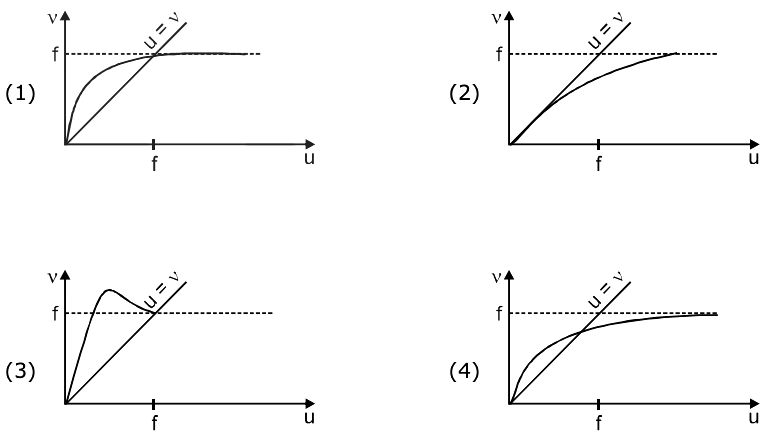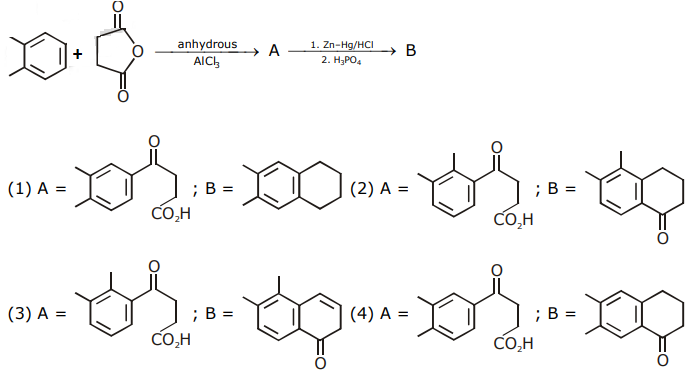Physics
1. Three different processes that can occur in an ideal monatomic gas are shown in the P vs V diagram. The paths are labelled as A → B, A → C and A → D. The change in internal energies during these processes are taken as EAB, EAC and EAD and the work done as WAB, WAC and WAD. The correct relation between these parameters are:

(1) EAB = EAC = EAD, WAB > 0, WAC = 0, WAD < 0
(2) EAB > EAC > EAD, WAB < WAC < WAD
(3) EAB < EAC < EAD, WAB > 0, WAC > WAD
(4) EAB = EAC = EAD, WAB > 0, WAC = 0, WAD > 0
2. With increasing biasing voltage of a photodiode, the photocurrent magnitude :
(1) increases initially and saturates finally
(2) remains constant
(3) increases linearly
(4) increases initially and after attaining certain value, it decreases
3. A square loop of side 2a, and carrying current I, is kept in XZ plane with its centre at the origin. A long wire carrying the same current I is placed parallel to the z-axis and passing through the point (0, b, 0), (b > > a). The magnitude of the torque on the loop about the z-axis is given by:
(1) ![]()
(2) ![]()
(3) ![]()
(4) ![]()
4. Assume that the displacement (s) of air is proportional to the pressure difference (Δp) created by a sound wave. Displacement(s) further depends on the speed of sound (v), the density of air (⍴) and the frequency (f). If Δp ~ 10Pa, v ~ 300 m/s, ⍴ ~ 1 kg / m3 and f ~ 1000 Hz, then s will be of the order of (take the multiplicative constant to be 1)
(1) 1 mm
(2) 10 mm
(3) 1/10 mm
(4) 3/100 mm
5. Two capacitors of capacitances C and 2C are charged to potential differences V and 2V, respectively. These are then connected in parallel in such a manner that the positive terminal of one is connected to the negative terminal of the other. The final energy of this configuration is:
(1) zero
(2) ![]()
(3) ![]()
(4) ![]()
6. A helicopter rises from rest on the ground vertically upwards with a constant acceleration g. A food packet is dropped from the helicopter when it is at a height h. The time taken by the packet to reach the ground is close to [g is the acceleration due to gravity]:
(1) 
(2) 
(3) 
(4) 
7. A bullet of mass 5 g, travelling with a speed of 210 m/s, strikes a fixed wooden target. One half of its kinetic energy is converted into heat in the bullet while the other half is converted into heat in the wood. The rise of temperature of the bullet if the specific heat of its material is 0.030 cal/(g – °C) (1 cal = 4.2 × 107 ergs) close to:
(1) 38.4°C
(2) 87.5°C
(3) 83.3°C
(4) 119.2°C
8. A wheel is rotating freely with an angular speed on a shaft. The moment of inertia of the wheel is I and the moment of inertia of the shaft is negligible. Another wheel of the moment of inertia 3I initially at rest is suddenly coupled to the same shaft. The resultant fractional loss in the kinetic energy of the system is:
(1) 3/4
(2) 0
(3) 5/6
(4) 1/4
9. A balloon is moving up in air vertically above a point A on the ground. When it is at a height h1, a girl standing at a distance d(point B) from A (see figure) sees it at an angle 45° with respect to the vertical. When the balloon climbs up a further height h2, it is seen at an angle 60° with respect to the vertical if the girl moves further by a distance 2.464 d (point C). Then the height h2 is (given tan 30° = 0.5774):

(1) 0.464 d
(2) d
(3) 0.732 d
(4) 1.464 d
10. An electrical power line, having a total resistance of 2Ω, delivers 1 kW at 220 V. The efficiency of the transmission line is approximately:
(1) 72%
(2) 91%
(3) 85%
(4) 96%
11. Activities of three radioactive substances A, B and C are represented by the curves A, B and C, in the figure. Then their half-lives T1/2 (A) : T1/2 (B) : T1/2 (C) are in the ratio:

(1) 3 : 2 : 1
(2) 2 : 1 : 1
(3) 4 : 3 : 1
(4) 2 : 1 : 3
12. The value of the acceleration due to gravity is g1 at a height h = R/ 2 (R = radius of the earth) from the surface of the earth. It is again equal to g1 at a depth d below the surface of the earth. The ratio (d / R) equals :
(1) 4/9
(2) 1/3
(3) 5/9
(4) 7/9
13. A hollow spherical shell at outer radius R floats just submerged under the water surface. The inner radius of the shell is r. If the specific gravity of the shell material is 27 / 8 w.r.t water, the value of r is:
(1) 4/9 R
(2) 8/9 R
(3) 1/3 R
(4) 2/3 R
14. In a resonance tube experiment when the tube is filled with water up to a height of 17.0 cm from the bottom, it resonates with a given tuning fork. When the water level is raised the next resonance with the same tuning fork occurs at a height of 24.5 cm. If the velocity of sound in air is 330 m/s, the tuning fork frequency is:
(1) 2200 Hz
(2) 550 Hz
(3) 3300 Hz
(4) 1100 Hz
15. A solid sphere of radius R carries a charge Q + q distributed uniformly over its volume. A very small point-like piece of it of mass m gets detached from the bottom of the sphere and falls down vertically under gravity. This piece carries charge q. If it acquires a speed v when it has fallen through a vertical height y (see figure), then : (assume the remaining portion to be spherical).

(1) 
(2) 
(3) 
(4) 
16. A galvanometer of resistance G is converted into a voltmeter of range 0 – 1V by connecting a resistance R1 in series with it. The additional resistance that should be connected in series with R1 to increase the range of the voltmeter to 0 – 2V will be:
(1) G
(2) R1
(3) R1 – G
(4) R1 + G
17. Number of molecules in a volume of 4 cm3 of a perfect monatomic gas at some temperature T and at a pressure of 2 cm of mercury is close to? (Given, mean kinetic energy of a molecule (at T) is 4 × 10–14 erg, g = 980 cm/s2, density of mercury = 13.6 g/cm3)
(1) 4.0 × 1018
(2) 4.0 × 106
(3) 5.8 × 1016
(4) 5.8 × 1018
18. An electron is constrained to move along the y-axis with a speed of 0.1 c (c is the speed of light) in the presence of electromagnetic wave, whose electric field is E = 30j sin (1.5 × 107 t – 5 × 10–2x) V/m. The maximum magnetic force experienced by the electron will be : (given c = 3 × 108 ms–1 and electron charge = 1.6 × 10–19C)
(1) 2.4 × 10–18 N
(2) 4.8 × 10–19 N
(3) 3.2 × 10–18 N
(4) 1.6 × 10–19 N
19. For a concave lens of focal length f, the relationship between object and image distances u and v, respectively, from its pole can best be represented by (u = is the reference line) :

20. A physical quantity z depends on four observables a, b, c and d, as  The percentages of error in the measurement of a, b, c and d are 2% , 1.5%, 4% and 2.5% respectively. The percentage of error in z is :
The percentages of error in the measurement of a, b, c and d are 2% , 1.5%, 4% and 2.5% respectively. The percentage of error in z is :
(1) 16.5%
(2) 12.25%
(3) 13.5%
(4) 14.5%
21. A particle of mass 200 Me V/c2 collides with a hydrogen atom at rest. Soon after the collision, the particle comes to rest, and the atom recoils and goes to its first excited state. The initial kinetic energy of the particle (in eV) is N/4. The value of N is : (Given the mass of the hydrogen atom to be 1 GeV/c2)_____.
22. Two concentric circular coils, C1 and C2, are placed in the XY plane. C1 has 500 turns, and a radius of 1 cm. C2 has 200 turns and a radius of 20 cm. C2 carries a time-dependent current I (t) = (5t2 – 2t + 3) A where t is in s. The emf induced in C1 (in mV), at the instant t = 1s is 4/x. The value of x is_____.
23. A beam of electrons of energy E scatters from a target having atomic spacing of 1Å. The first maximum intensity occurs at θ = 60° Then E (in eV) is ______. (Planck constant h = 6.64 × 10–34 Js, 1 eV = 1.6 × 10–19 J, electron mass m = 9.1 × 10–31 kg)
24. A compound microscope consists of an objective lens of focal length 1 cm and an eyepiece of focal length 5 cm with a separation of 10 cm. The distance between an object and the objective lens, at which the strain on the eye is minimum is n/40 cm. The value of n is _____.
25. A force ![]() acts at a point
acts at a point ![]() Then the magnitude of torque about the point
Then the magnitude of torque about the point ![]() will be √x N–m. The value of x is ______.
will be √x N–m. The value of x is ______.
Chemistry
1. The potential energy curve for the H2 molecule as a function of internuclear distance is:

2.The most appropriate reagent for conversion of C2H5CN into CH3CH2CH2NH2 is:
(1) NaBH4
(2) Na(CN)BH3
(3) CaH2
(4) LIAlH4
3. Which of the following is not an essential amino acid?
(1) Valine
(2) Tyrosine
(3) Lysine
(4) Leucine
4. Which of the following derivatives of alcohols is unstable in an aqueous base?

5. The structure of PCl5 in the solid state is:
(1) Square planar [PCl4]+ and octahedral [PCl6]–
(2) Tetrahedral [PCl4]+ and octahedral [PCl6]–
(3) Trigonal bipyramidal
(4) Square pyramidal
6. A diatomic molecule X2 has a body-centred cubic (bcc) structure with a cell edge of 300 pm. The density of the molecule is 6.17 g cm–3. The number of molecules present in 200 g of X2 is:(Avogadro constant (NA) = 6 × 1023 mol–1)
(1) 8 NA
(2) 2 NA
(3) 40 NA
(4) 4 NA
7. The equation that represents the water-gas shift reaction is:

8. The increasing order of the acidity of the α-hydrogen of the following compounds

(1) (D) < (C) < (A) < (B)
(2) (A) < (C) < (D) < (B)
(3) (C) < (A) < (B) < (D)
(4) (B) < (C) < (A) < (D)
9. Indentify the correct molecular picture showing what happens at the critical micellar concentration (CMC) of an aqueous solution of a surfactant ![]()

(1) (B)
(2) (A)
(3) (C)
(4) (D)
10. If a person is suffering from the deficiency of nor-adrenaline, what kind of drug can be suggested?
(1) Antihistamine
(2) Antidepressant
(3) Anti-inflammatory
(4) Analgesic
11. The values of the crystal field stabilization energies for a high spin d6 metal ion in octahedral and tetrahedral fields, respectively, are:
(1) –2.4 Δ0 and –0.6 Δt
(2) –1.6 Δ0 and –0.4 Δt
(3) –0.4 Δ0 and –0.27 Δt
(4) –0.4 Δ0 and –0.6 Δt
12. A flask contains a mixture of compounds A and B. Both compounds decompose by first order kinetics. The half-lives for A and B are 300 s and 180 s, respectively. If the concentrations of A and B are equal initially, the time required for the concentration of A to be four times that of B (in s) is: (Use ln 2 = 0.693)
(1) 180
(2) 300
(3) 120
(4) 900
13. The increasing order of basicity of the following compounds is:

(1) (D) < (A) < (B) < (C)
(2) (A) < (B) < (C) < (D)
(3) (B) < (A) < (D) < (C)
(4) (B) < (A) < (C) < (D)
14. The condition that indicates a polluted environment is:
(1) pH of rain water to be 5.6
(2) BOD value of 5 ppm
(3) 0.03% of CO2 in the atmosphere
(4) eutrophication
15. In the sixth period, the orbitals that are filled are:
(1) 6s, 5d, 5f, 6p
(2) 6s, 4f, 5d, 6p
(3) 6s, 6p, 6d, 6f
(4) 6s, 5f, 6d, 6p
16. The difference between the radii of 3rd and 4th orbits of Li2+ is ΔR1. The difference between the radii of 3rd and 4th orbits of He+ is ΔR2. Ratio ΔR1: ΔR2 is:
(1) 8 : 3
(2) 3 : 8
(3) 3 : 2
(4) 2 : 3
17. In the following reaction sequence the major products A and B are:

18. The correct electronic configuration and spin-only magnetic moment (BM) of Gd3+ (Z = 64), respectively, are:
(1) [Xe] 5f7 and 7.9
(2) [Xe] 4f7 and 7.9
(3) [Xe] 5f7 and 8.9
(4) [Xe] 4f7 and 8.9
19. An Ellingham diagram provides information about:
(1) The pressure dependence of the standard electrode potentials of reduction reactions involved in the extraction of metals.
(2) The conditions of pH and potential under which a species is thermodynamically stable.
(3) The kinetics of the reduction process.
(4) The temperature dependence of the standard Gibbs energies of formation of some metal oxides.
20. Consider the following reaction:
N2O4(g) ⇌ 2NO2(g); ∆H° = +58 kJ
For each of the following cases (a, b), the direction in which the equilibrium shifts is:
(a) Temperature is decreased.
(b) Pressure is increased by adding N2 at constant T.
(1) (a) towards reactant, (b) towards product
(2) (a) towards reactant, (b) no change
(3) (a) towards product, (b) towards reactant
(4) (a) towards product, (b) no change
21. The minimum number of moles of O2 required for complete combustion of 1 mole of propane and 2 moles of butane is _____.
22. The number of chiral carbon(s) present in piptide, Iie-Arg-Pro, is ______ .
23. A soft drink was bottled with a partial pressure of CO2 of 3 bar over the liquid at room temperature. The partial pressure of CO2 over the solution approaches a value of 30 bar when 44 g of CO2 is dissolved in 1 kg of water at room temperature. The approximate pH of the soft drink is ______ × 10–1
(First dissociation constant of H2CO3= 4.0 × 10–7; log 2 = 0.3; density of the soft drink= 1 g mL–1)
24. An oxidation-reduction reaction in which 3 electrons are transferred has a ΔGº of 17.37 kJmol–1 at 250C. The value of E0cell (in V) is ______ × 10–2. (1 F = 96,500 C mol–1)
25. The total number of coordination sites in ethylenediaminetetraacetate (EDTA4–) is _____.
Mathematics
1. If the volume of a parallelopiped, whose coterminuous edges are given by the vectors ![]() and
and ![]() is 158 cu. units then:
is 158 cu. units then:
(1) ![]()
(2) ![]()
(3) n = 9
(4) n = 7
2. A survey shows that 73% of the persons working in an office like coffee, whereas 65% like tea. If x denotes the percentage of them, who like both coffee and tea, then x cannot be:
(1) 63
(2) 54
(3) 38
(4) 36
3. The mean and variance of 7 observations are 8 and 16, respectively. If five observations are 2,4,10,12,14, then the absolute difference of the remaining two observations is:
(1) 1
(2) 4
(3) 3
(4) 2
4. If 210 + 29 × 31 + 28 × 32 +…..+ 2 × 39 + 310 = S−211, then S is equal to:
(1) 311
(2) 
(3) 2 ∙ 311
(4) 311 − 212
5. If 32 sin2α−1,14 and 34−2sin2α are the first three terms of an A.P. for some α , then the sixth term of this A.P. is:
(1) 65
(2) 81
(3) 78
(4) 66
6. If the common tangent to the parabolas, y2 = 4x and x2 = 4y also touches the circle, x2 + y2 = c2, then c is equal to:
(1) 1/2
(2) 1/4
(3) 1/√2
(4) 1/2√2
7. If the minimum and the maximum values of the function ![]() defined by
defined by  are m and M respectively, then the ordered pair (m, M) is equal to:
are m and M respectively, then the ordered pair (m, M) is equal to:
(1) (0, 4)
(2) (−4, 0)
(3) (−4, 4)
(4) (0, 2√2)
8. Let λ ∈ the system of linear equations
2x1 − 4x2 + λx3 = 1
x1 − 6x2 + x3 = 2
λx1 − 10x2 + 4x3 = 3
is inconsistent for:
(1) exactly two values of λ
(2) exactly one negative value of λ.
(3) every value of λ.
(4) exactly one positive value of λ.
9. If the point P on the curve, 4x2 + 5y2 = 20 is farthest from the point Q(0, −4), then PQ2 is equal to:
(1) 48
(2) 29
(3) 21
(4) 36
10. The product of the roots of the equation 9x2 – 18 |x| + 5 = 0 is :
(1) 25/81
(2) 5/9
(3) 5/27
(4) 25/9
11. If y = y(x) is the solution of the differential equation  satisfying y(0) = 1, then the value of y(loge 13) is:
satisfying y(0) = 1, then the value of y(loge 13) is:
(1) 1
(2) 0
(3) 2
(4) −1
12. If S is the sum of the first 10 terms of the series ![]() then tan(S) is equal to:
then tan(S) is equal to:
(1) 5/11
(2) 5/6
(3) −6/5
(4) 10/11
13. The value of  is:
is:
(1) π/2
(2) π/4
(3) π
(4) 3π/2
14. If (a, b, c) is the image of the point (1,2,−3) in the line, ![]() then a + b + c is
then a + b + c is
(1) 2
(2) 3
(3) −1
(4) 1
15. If the function  is twice differentiable, then the ordered pair (k1, k2) is equal to:
is twice differentiable, then the ordered pair (k1, k2) is equal to:
(1) (1, 1)
(2) (1, 0)
(3) (1/2, −1)
(4) (1/2, 1)
16. If the four complex numbers ![]() and z – 2Re(z) represent the vertices of a square of side 4 units in the Argand plane, then |z| is equal to:
and z – 2Re(z) represent the vertices of a square of side 4 units in the Argand plane, then |z| is equal to:
(1) 2
(2) 4
(3) 4√2
(4) 2√2
17. If ![]()
![]() where c is a constant of integration, then g(0) is equal to:
where c is a constant of integration, then g(0) is equal to:
(1) 2
(2) e
(3) 1
(4) e2
18. The negation of the Boolean expression x ↔ y is equivalent to:
(1) (x˄y) ˄(∼x˅∼y)
(2) (x˄y) ˅ (∼x˄∼y)
(3) (x˄∼y) ˅ (∼x˄∼y)
(4) (∼x˄y) ˅ (∼x˄∼y)
19. If α is positive root of the equation, p(x) = x2 – x – 2 = 0, then  is equal to :
is equal to :
(1) 1/2
(2) 3/√2
(3) 3/2
(4) 1/√2
20. If the co-ordinates of two points A and B are (√7, 0) and (−√7, 0) respectively and P is any point on the conic, 9x2 + 16y2 = 144, then PA+PB is equal to :
(1) 6
(2) 16
(3) 9
(4) 8
21. The natural number m, for which the coefficient of x in the binomial expansion of is  1540 is………….
1540 is………….
22. Four fair dice are thrown independently 27 times. Then the expected number of times, at least two dice show up a three or a five, is……………
23. Let  for −10 < x < 10, where [t] denotes the greatest integer function. Then the number of points of discontinuity of f is equal to………….
for −10 < x < 10, where [t] denotes the greatest integer function. Then the number of points of discontinuity of f is equal to………….
24. The number of words, with or without meaning, that can be formed by taking 4 letters at a time from the letters of the word ’SYLLABUS’ such that two letters are distinct and two letters are alike, is
25. If the line, 2x − y + 3 = 0 is at a distance 1/√5 and 2/√5 from the lines 4x − 2y + α = 0 and 6x − 3y + β = 0, respectively, then the sum of all possible values of α and β is………………
Latest Govt Job & Exam Updates: